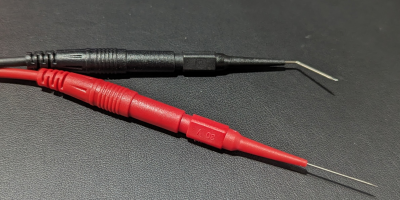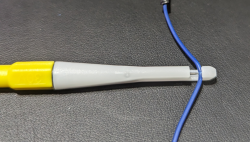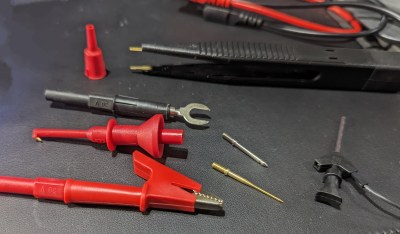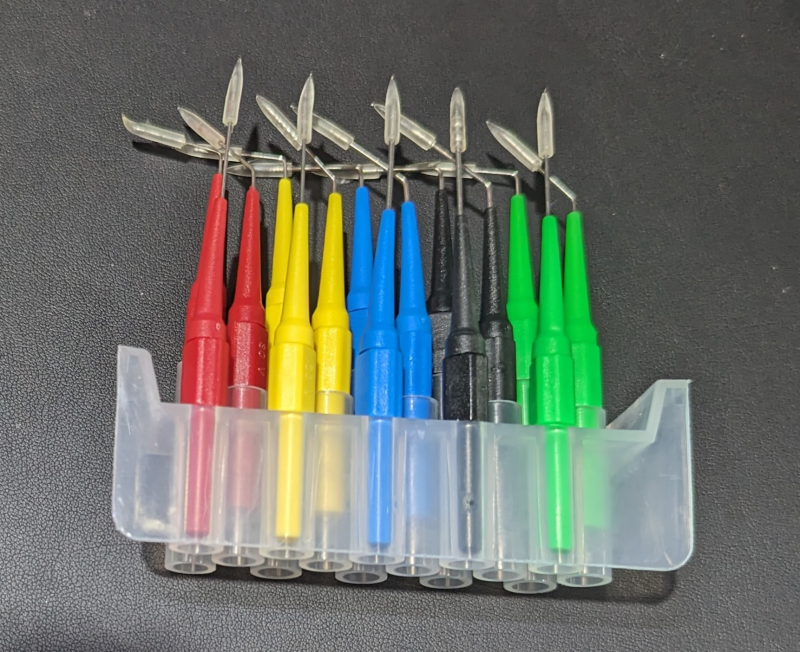One of the most basic tools for tinkering with electronics is a multimeter. Today, even a cheap meter has capabilities that would have been either very expensive or unobtainable back in the 1970s. Still, even then, a meter was the most affordable way to do various tasks around the shop. Is this cable open? Are these two wires shorted? What’s the value of this resistor? Is the circuit getting power? Is the line voltage dropping? You can answer all those questions — and many more — with a basic meter. But there’s one thing that hasn’t changed much over the years: probes. That’s a shame because there are a lot of useful options.
The probes that came with your meter probably have much in common with the probes a 1970-era meter had. Yeah, the banana plugs probably have a little plastic cover, and the plastic itself might be a little different. Parts are small these days, so the tips might be a little finer than older probes. But if you sent your probes back in time, few people would notice them.
The Blinders Syndrome
One problem is that those probes are usually good enough. We’ve all clipped an alligator clip to a test probe. I’ve even fashioned super pointy probes out of syringes. Years ago, I bought an expensive kit with many attachments I rarely use, like little hooks and spade lugs. Then, I happened to go down the wrong aisle at Harbor Freight.

In the automotive section, I noticed a tidy plastic box labeled “22 pc. back probe kit.” I’d never heard the term “back probe,” but it was clearly some sort of wire. It turns out the kit has a bunch of very fine needles on banana jacks and some patch cables to connect them to your meter.
They are “back probes” because you can jam them in the back of connectors next to the wire. There are five colors of needles, and each color set has three items: a straight needle, a bent needle, and a 90-degree bend needle.
I’d never heard of this, and that started me down the rabbit hole of looking at what other exotic probes were out there. If you search the usual sources for “back probe,” you’ll see plenty of variations. There are also tons of inexpensive probe kits with many useful tips for different situations. Like everything, the price was much lower than I had paid for the rarely used kit I bought years ago. The only thing I really use out of that kit are the test hook clips and you can buy those now for a few bucks that just push over your probes.
Choices

You could probably use the needles to stick through insulation, too. But if that’s your goal, they make piercing clip test probes specifically for that purpose. A little plastic holder has a hook for your wire and a needle that threads in to penetrate the wire.

I also picked up some little alligator clips that slide over standard 2mm probe tips. These are very handy and prevent you from having to clip a lead to your probe so you can clip the other end to the circuit. However, if you look for a “test lead kit,” you’ll find many options for about $20. One kit had interchangeable probe tips, alligator clips, spades, SMD tweezers, and tiny hooks for IC legs. The alligator clips on the one I bought are the newer style that has a solid insulating body — not the cheap rubbery covers. They feel better and are easier to handle, too.
Breadboarding

Of course, you can make your own solderless breadboard jumpers, and you’ve probably seen that you can buy jumpers of various kinds. But if you search, you can even find test probes with breadboard wire ends. The other end will terminate in a test hook or alligator clips. You can also get them with banana plugs on the end to plug right into your meter. You can usually find versions with the male pin for a breadboard or a female receptacle for connecting to pins.
Of course, we love hacking components to fit on breadboards. We’ve also seen custom slip-on adapters, which are worth checking out if you are looking to up your probe game.

















This is one of the electrical engineering areas that I feel we are not quite there yet. I mean, different approaches exist because not one is good enough.
Al, you should contact Harbor Freight and tell them to watch for an increase in sales on the back probes…. maybe you can weasel a gift card out of them.
This is not arstechnica
I have yet to encounter a wrong aisle to go down at Harbor Freight.
I will have to look for that backprobe set on my next visit. Appears to cost about 3x the HF meter that I will probably use it with on a car.
The probes should be better than jamming the standard big fat meter leads into the back of amp style connectors for some work I need to do on my early-digital cocktail pinball machine.
There are t shaped needles for sowing that work great for this. Do a quick search and you will find them. They are cheap and sold by 100 count so you will never run out.
T-pins are great. Years ago I started work at a place where the lead tech kept a box of T-PINS front-and-center on his bench. I thought it weird until a couple of weeks later when I watched him using them. I mentioned I should get some and the next day he handed me a box. His wife was a professional seamstress and literally bought them by the case.
One can not neglect the one that does it all- Mueller JP-8783 (and some other manufacturers make some that are all but indistinguishable)
Bed of nails. Check.
Insulation piercing spike. Check,
Alligator jaw. Check.
Comes with 2mm socket. Check.
Or 4mm socket. Check. Or screw.
Check. Or solder lug. Check.
Or threaded socket. Check.
With a rubber boot. Check.
Or moldover. Check.
Who needs anything else?
Oh, wait. What? Copper wired landline phones are no longer a thing? Really? What are the kids using now? What? Ok, maybe a minigrabber, too, then.
I won’t swear all of these options are still available from Mueller, but all are still available somewhere, last time I looked a couple years ago…
These clips really are a whole other level of multipurpose tool.
I have a few on some telecom test equipment and they will probably outlive me… but nothing else comes even close.
If you want some of the best single-purpose clips and probes on the market, Hirschmann makes them.
https://www.sks-kontakt.de/en/test-measurement/products
Their catalog is also a trap for spending lots of money, but damn if they don’t make the best alligator clip I have ever used…
I’d also want thin probe that is conductive only on one side, very handy for SMD IC pins.
There recently was a lively discussion on Twitter about miniature test hooks. I really like SDK08’s from ali https://x.com/krekr/status/1772658989131510198
You can also get magnet test probes for when there is nothing good to clamp onto but there is a ferrous surface. Havn’t found any as small as I would like though.
A long time ago I bought some Hirschmann 2mm banana jacks and never did much with them.
And then I had an epiphany that brightened my electronics work.
1. I took two of such 2mm banana jacks. drilled a longitudional hole in it
(approx. 0.7mm, a few mm deep)
2. Took the tips of some regular sowing needles and soldered them in the holes.
3. Added dual concutor speaker wire.
4. Added two 4mm banana jacks.
And these have been my DMM probes ever since. Whenever I see someone promoting those bushmaster probes, I think of how big and clumsy they are.
I can stick my probes in or under wire isolation if needed.
I can stick my probes in between strands of multi strand wire.
I can stick my probes into a breadboard and they just stay there.
I can stick my probes right though dirt or oxide layers.
I have also put a piece of bicycle inner tube in between my DMM and it’s “rubber holster”. Normally there are some Hirschmann 2mm crocodile clips on that piece of inner tube. That way they always stay with my DMM and I never loose them.
The only unfortunate thing is the form of these crocodile clips. The form of them is such that you can clamp thin things or wires nicely, but they are very bad at anything of over a few mm thick. Even the round shaft of a 4mm regular banana jack can barely be clamped by these Hirschmann clamps.
After 45 years, my most used and loved probes are Pomona 5359A. Thin wires that don’t seem to tangle and probes with very long extendable, insulated sharp ended tips. Reaches into equipment that I would otherwise have to disassemble in order to measure. They weren’t cheap.
On the other end of the spectrum, I like Mechanic P30 (or equivalent) probes that I got from my favorite Asian low cost vendor. Nice silicone leads, with good sturdy handles and probe tips are long and wicked sharp. Great for tiny SMD pins.
Never have warmed up to the probe kits with mulitple attachments. I like the attachments but oddly the probe tips never seemed worthwhile using.
I’m a big fan of Hirschmann MPS 2 spring loaded micro probes. They are very reliable and their suspension lets you hold both probes in one hand without having them separate from the contacts under test.
I got a couple of sets of those for work, they are very good for performing in circuit measurements, without slipping and ripping up components.
I had previously made my own at home by soldering some wire to some spring pins and isolating them with some tape. Those too work remarkably well.
The CORRECT way to use BACK PROBES (only a last resort)!!!
https://www.youtube.com/watch?v=TS9Dr1Rx6Lk
https://www.youtube.com/watch?v=TS9Dr1Rx6Lk
THAT is the correct way? I thought the “back” referred to the probe penetrating the silicone seal at the rear of the connector… like the manufacturer’s sales brochure shows.
@Lucy said: “THAT is the correct way? I thought the “back” referred to the probe penetrating the silicone seal at the rear of the connector… like the manufacturer’s sales brochure shows.”
Watch the video to the end. The proper way to use the pointy probe is to NOT pierce the insulation.
I bought a cheap set of multimeter probes on AliExpress with interchangable ends, they are definitely good enough quality and the number of different ends it has are quite useful.
The default one I have on is a banana plug with a pointed end, pointy enough to work with breadboards (it doesn’t hold in but it is long enough and pointy enough to make contact) and a few different connectors for it, like crocodile clips, spade connectors, etc.
It also has some finer tips, some really thin and sharp (thin enough to actually put into breadboards), others just long and a very useful one for me, long thin sticks with a concave end, these are easy to press against header pins, both sides, including the soldered side and the concave end stops them from slipping off easily.
The wire of the probes has silicone insulation too and is very flexible.
The kit didn’t cost a lot of money and it is at least as good electrically as the probes that came with my multimeter whilst being better mechanically, better wires, interchangable tips, etc.
I’ll shake my rubber booties on that thin plastic cap crap covering the up teeth any day.
They’re tangle free to boot! Pun! I still have a few of the bigger Muller clips too.
Sharpened piano wire, harder than most anything and holds a point. Scribe things on the board as you go without a schematic. It’s on the end of a red plastic handle with a loop of wire to clip to on the other end as well as my needle in an gators mouth with the red handle for the main meter or two. This combo saves changing ends or needing adapters across big ole tubes to surface mount tech all in a day. Try it there’s nothing to forget inside the patient. Clip or probe anytime.
Check out ‘PCBite’ by Sensepeek as well. https://sensepeek.com/pcbite-20
basically the (expensive) PRO-Version of ‘PCB Workstation with articulated arms’ by giufini (free to print or you can order a kit).
PCBite uses ‘gravity assisted’ spring loaded needles so they stay in place. There are Scope-connectable heads as well. Besides mesuring on Testpoints or package-leads, I’ve used them for flashing a few PCBs without building a custom needle-adapter or soldering any wires.
For normal, hand-held probes, I usually use spring-loaded needles (e.g. Hirschmann PRUEF2610) – not for high current tough :D.
I printed a PCB frame and set of “crane probes” from here: https://www.thingiverse.com/thing:2111631
It uses acupuncture needles, which they no longer sell by that name on Amazon (I guess they don’t host pseudo-medical equipment) but you can still buy a box of them as “3d printer cleaning needles”
It lets you cram a lot of tiny probes around a surface mount IC without stress.